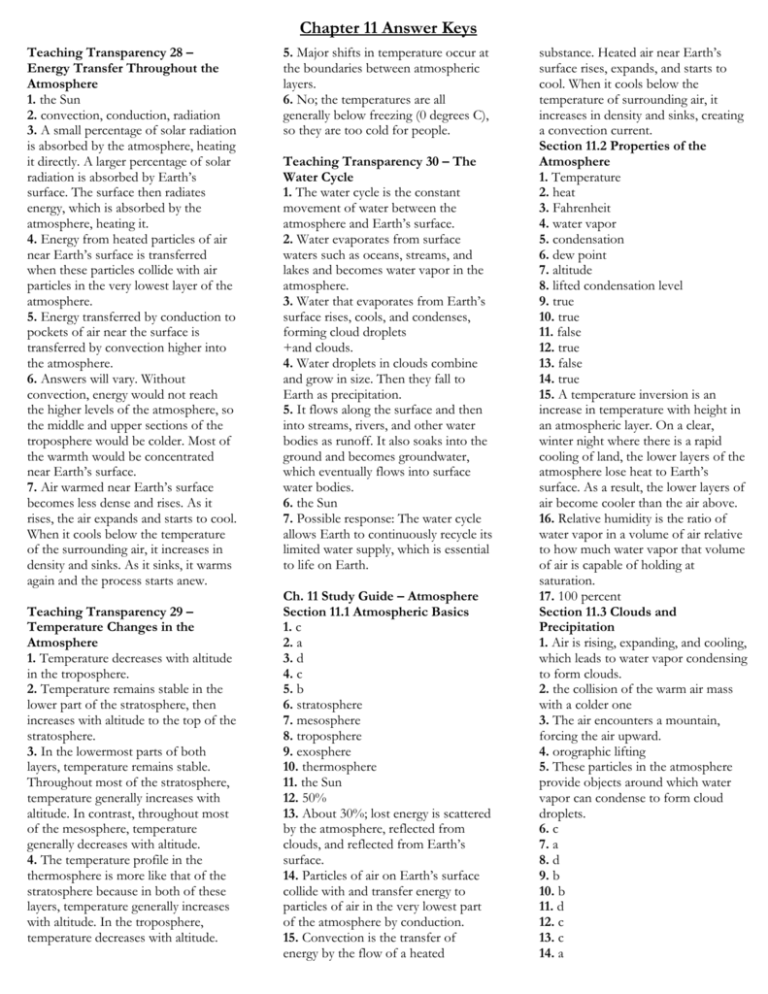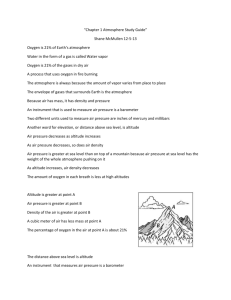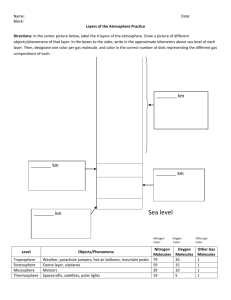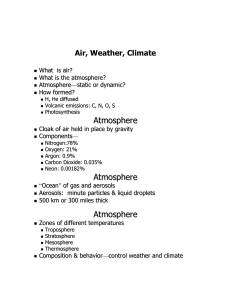Chapter 11 Answer Keys: Atmosphere & Water Cycle
advertisement

Chapter 11 Answer Keys Teaching Transparency 28 – Energy Transfer Throughout the Atmosphere 1. the Sun 2. convection, conduction, radiation 3. A small percentage of solar radiation is absorbed by the atmosphere, heating it directly. A larger percentage of solar radiation is absorbed by Earth’s surface. The surface then radiates energy, which is absorbed by the atmosphere, heating it. 4. Energy from heated particles of air near Earth’s surface is transferred when these particles collide with air particles in the very lowest layer of the atmosphere. 5. Energy transferred by conduction to pockets of air near the surface is transferred by convection higher into the atmosphere. 6. Answers will vary. Without convection, energy would not reach the higher levels of the atmosphere, so the middle and upper sections of the troposphere would be colder. Most of the warmth would be concentrated near Earth’s surface. 7. Air warmed near Earth’s surface becomes less dense and rises. As it rises, the air expands and starts to cool. When it cools below the temperature of the surrounding air, it increases in density and sinks. As it sinks, it warms again and the process starts anew. Teaching Transparency 29 – Temperature Changes in the Atmosphere 1. Temperature decreases with altitude in the troposphere. 2. Temperature remains stable in the lower part of the stratosphere, then increases with altitude to the top of the stratosphere. 3. In the lowermost parts of both layers, temperature remains stable. Throughout most of the stratosphere, temperature generally increases with altitude. In contrast, throughout most of the mesosphere, temperature generally decreases with altitude. 4. The temperature profile in the thermosphere is more like that of the stratosphere because in both of these layers, temperature generally increases with altitude. In the troposphere, temperature decreases with altitude. 5. Major shifts in temperature occur at the boundaries between atmospheric layers. 6. No; the temperatures are all generally below freezing (0 degrees C), so they are too cold for people. Teaching Transparency 30 – The Water Cycle 1. The water cycle is the constant movement of water between the atmosphere and Earth’s surface. 2. Water evaporates from surface waters such as oceans, streams, and lakes and becomes water vapor in the atmosphere. 3. Water that evaporates from Earth’s surface rises, cools, and condenses, forming cloud droplets +and clouds. 4. Water droplets in clouds combine and grow in size. Then they fall to Earth as precipitation. 5. It flows along the surface and then into streams, rivers, and other water bodies as runoff. It also soaks into the ground and becomes groundwater, which eventually flows into surface water bodies. 6. the Sun 7. Possible response: The water cycle allows Earth to continuously recycle its limited water supply, which is essential to life on Earth. Ch. 11 Study Guide – Atmosphere Section 11.1 Atmospheric Basics 1. c 2. a 3. d 4. c 5. b 6. stratosphere 7. mesosphere 8. troposphere 9. exosphere 10. thermosphere 11. the Sun 12. 50% 13. About 30%; lost energy is scattered by the atmosphere, reflected from clouds, and reflected from Earth’s surface. 14. Particles of air on Earth’s surface collide with and transfer energy to particles of air in the very lowest part of the atmosphere by conduction. 15. Convection is the transfer of energy by the flow of a heated substance. Heated air near Earth’s surface rises, expands, and starts to cool. When it cools below the temperature of surrounding air, it increases in density and sinks, creating a convection current. Section 11.2 Properties of the Atmosphere 1. Temperature 2. heat 3. Fahrenheit 4. water vapor 5. condensation 6. dew point 7. altitude 8. lifted condensation level 9. true 10. true 11. false 12. true 13. false 14. true 15. A temperature inversion is an increase in temperature with height in an atmospheric layer. On a clear, winter night where there is a rapid cooling of land, the lower layers of the atmosphere lose heat to Earth’s surface. As a result, the lower layers of air become cooler than the air above. 16. Relative humidity is the ratio of water vapor in a volume of air relative to how much water vapor that volume of air is capable of holding at saturation. 17. 100 percent Section 11.3 Clouds and Precipitation 1. Air is rising, expanding, and cooling, which leads to water vapor condensing to form clouds. 2. the collision of the warm air mass with a colder one 3. The air encounters a mountain, forcing the air upward. 4. orographic lifting 5. These particles in the atmosphere provide objects around which water vapor can condense to form cloud droplets. 6. c 7. a 8. d 9. b 10. b 11. d 12. c 13. c 14. a







